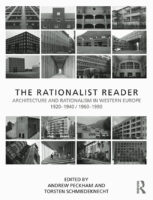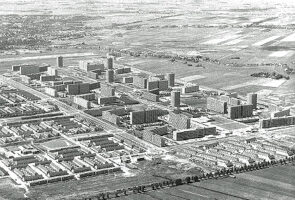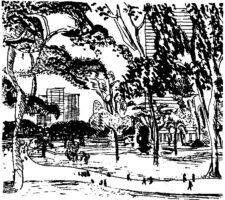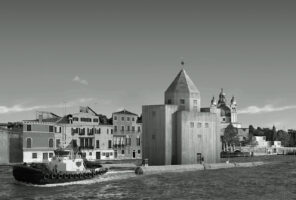The Heroism of Rationalism
Postscript to: Andrew Peckham, Torsten Schmiedeknecht (ed.), The Rationalist Reader, Architecture and rationalism in Western Europe 1920-1940/ 1960-1990, Routledge, London 2013
i
I grew up in a country that regards itself as innocent. The generation of my grandparents had resisted the German occupation of the Netherlands. For my parents’ generation the WW2 and the bombing of Rotterdam are traumatic memories. However the atrocities of Dutch imperialism in Indonesia and South Africa are remote, geographically and historically, and erased from collective memory. Historical understanding in the Netherlands is shallow. 400 years ago, the Dutch river Delta was largely un-urbanized marshland where agricultural production was impossible. Even today, what few prehistoric, Roman and medieval archeological relics remain are safely buried in the mud. As a young architect, I was taught to work at constructing a contemporary landscape, rather than working in or with a territory. Everything looked possible. There was still a major shortage of housing that was ascribed to the damage of WW2. This was still the context from which the Superdutch architects emerged in the 1990s. With high spirit and unfailing good cheer they supplied the country with their sugarmodernism and, supported by generous state subsidies, exported their problem-free design ethos to exotic places. Superdutch architecture was a product of a nation of traders.

My German friends inherited a different history. Their feelings of guilt may well be as unjust as Dutch innocence and perceived victimization, but there was no way they can afford to neglect the history of their country. The Critical Reconstruction of Berlin that developed in the 1990s had none of the positivist rhetoric of the contemporary Superdutch. The Berlin Wall had just fallen. Answers had to be found to the complex new political reality following Die Wende. These inevitably attracted a degree of melancholy, given the ambivalence attached to reunification. The objectives of the German bourgeoisie and the Kreuzberg squatters coincided in a practice of cautious urban renewal in which German history was neither preserved (there was little left anyway) nor declared sacrosanct. Berlin’s critical reconstruction had to demonstrate the vitality and political self-awareness of German culture – this time without a Marshall Plan.
In the critical reconstruction of Berlin, architecture was confirmed as a discipline that negotiates the relationship between collective decisions and private action; while even today, Rotterdam celebrates its state of perpetual instability and regards the city as available land, ready to build on. In Rotterdam the cultural meaning of architecture has been elusive.
Today, German and Dutch architects share a European market. Our generation is facing another reality. Big themes have gone. All the museums necessary have been built. No more theatres are needed. Our cities are completed. Like many European colleagues of different nationalities we assume that our field of work must be the anonymous volume of urban expansion that our predecessors were unable to restrain: the post-war Plattenbau (prefabricated concrete estates in East Germany); the Banlieu (on the French urban periphery); the urban sprawl of the Veneto and Southern Switzerland, and the Flemish Nebula City. These urban realms are not well understood. Although they appear undesirable and weak in architectural form, they won’t go away. They are our part of our reality and, contingent with our hopes and fears, have become part of our city, so to speak. Interventions are called for in a considered order of priority.
ii

Looking back at a century of rationalism in architecture, rationalism has never been offered as, or aspired to, the status quo. It constitutes an ongoing engagement with ideas concerned about two particular topics: the question of urban form and the production of urban buildings. This Rationalism is about architecture and cities – asking which architecture and what city? Its ambitions are not inconsiderable. Rationalism attempts nothing less than to construct continuity between ideological objectives regarding our habitat and clear operative methods of design practice, and as such negotiates between collective intent and private enterprise. Rationalist ‘tools’ focus on the history of architecture, its analysis and its evidence of design methodologies. Rationalist architectural discourse seeks to demystify and depersonalize architecture, and in that particular sense engages the profession in political debate. Rationalism is practiced as a legacy of the European Enlightenment and Berlin has been a productive arena, both historically and following Die Wende.
iii
Whether in conceptualizing the city or in the production of its buildings, rationalist paradigms have shifted over the last 50 years. Urbanism has moved from the priority given to urban expansion towards a renewed interest in the historic city, whilst attitudes towards construction have moved from the axis of industrialization and standardization towards architectural craftsmanship and contextualism. This paradigm shift has been evident, although not exclusively, in various texts identified as rationalist – Le Corbusier’s Ville radieuse displaced by Aldo Rossi’s The Architecture of the City. The rhetoric of the Machine à habiter was set aside when Rossi’s Teatro del Mondo was towed into the Venice lagoon in 1979.
This is more than a caricature. It cannot be underestimated how a rationalist conception of reason has developed, through its rhetoric and imagery, into a position not to be disregarded. Rossi’s Teatro was imprinted on the retina: the world would have looked different without it. Through iconic symbols of this kind rationalism earned a degree of heroism. Its causes were worth fighting for. The arrival of the Teatro del Mondo in Venice asserted the claim that architecture from that moment on would be about the reinterpretation of historic urban, and architectural, models.
Meanwhile, the antique city is well protected. Our history and our urban monuments are cherished. La ville radieuse is no longer an option. Contemporary architecture is expected to carry a strong personal signature. Uniqueness has replaced the anonymity of craftsmanship and industrial standardization alike. Early Twentieth Century rationalist architecture has passed into history. Perhaps confusingly, that episode, once regarded as antagonistic to the historic city, has meanwhile provided its own canon and set of listed monuments. Our urban heritage incorporates conflicting ambitions, appearing as fragmented and without order. Relics from different periods have gained similar status. Urban and sub-urban residential areas have become part of the same urban constellation. Handcrafted buildings adjoin mass produced structures, contrasting uniqueness with utter blandness. The line between high and low culture has become blurred.
Rossi’s appreciation of urban space as a collection of primary artifacts against a backdrop of the unstable volume of normative building has become unworkable for architects working with the existing urban realm. Surrounded by a multidirectional aggregation of historic urban material, they still ask: which city and what architecture?
iv

The renewal of the post war urban realm, derided by Rossi’s contemporaries and allegedly unpopular with its inhabitants, serves as a case in point. This is a task architects can hardly afford to avoid, if only for its sheer extent. 50% or more of the housing stock of any Western European country is likely to have been produced after 1945. How well do we know and understand this urbanism, its architecture and the construction systems that served to produce it? What are the methodological criteria for interventions in these areas? What is a plausible long-term investment scenario? Or put more directly: should the resistance to blind ground floor facades be taken as phantom pain (given the loss of the urbanity of streets and squares) or as a desire to reintroduce such urban figures? And, should the rejection of an architectural vocabulary, the consequence of standardized construction systems, be an alibi for the creation a new well-crafted architecture at odds with the appearance of this context?
v
One can still aspire to a rationalist contribution to architectural design and professional discourse in our reassessment of the European post-war urban realm where a balance between collective and private initiatives is required. The alleged social and architectural weakness of this ‘city’ seems largely unsubstantiated. Again, the same questions remain topical: which city and what architecture is to be sought? Meanwhile, architecture has to retain its credibility in this polemical debate. An architectural discipline promoting its own enthusiasm will not readily be recognized for its capacity to handle the scale, requisite negotiations and compromises involved.

Architecture will have to give up its naiveté and come to terms with the incipient alienation of the post-war estates, with cities as they are and not what they should be, and with designs that ‘maintain’ cities and buildings as much as define or redefine them. This may be profitable work and serve a good cause, but it is also intrinsically un-heroic, at least in comparison to the buildings of previous generations of architects. Emblems that transform such an unspectacular architecture into an unarguable position as decisively as Rossi’s Teatro are, however, not yet imaginable.

